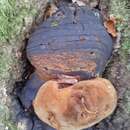pt-BR
nomes no trilho de navegação


Fomitiporia ist eine Pilzgattung aus der Familie der Borstenscheiblingsverwandten (Hymenochaetaceae), die von den Feuerschwämmen im engeren Sinn (Phellinus s. str.) abgetrennt wurde.
Die Typusart ist Fomitiporia langloisii.[1]
Das Hymenophor des Holzbewohners ist flach am Substrat anliegend, mehrjährig, untrennbar und steif. Der dünne Kontext ist braun. Die geschichteten Röhren sind ebenfalls braun, in der Regel dickwandig und ganzrandig.
Die rundlichen bis elliptischen Sporen sind glatt und farblos. Die Hyphen haben für gewöhnlich eine braune Farbe. Zystiden sind manchmal vorhanden.[1]
Für Europa werden folgende Arten angegeben bzw. sind dort zu erwarten:[2]
Tannen-Feuerschwamm
Fomitiporia hartigii
Sanddorn-Feuerschwamm
Fomitiporia hippophaëicola
Polsterförmiger Feuerschwamm
Fomitiporia punctata
Eichen-Feuerschwamm
Fomitiporia robusta
Fomitiporia ist eine Pilzgattung aus der Familie der Borstenscheiblingsverwandten (Hymenochaetaceae), die von den Feuerschwämmen im engeren Sinn (Phellinus s. str.) abgetrennt wurde.
Die Typusart ist Fomitiporia langloisii.
Fomitiporia is a genus of fungi in the family Hymenochaetaceae. According to a 2008 estimate, the widely distributed genus contains 11 species,[1] though three new species were identified in 2010 in sub-Saharan Africa using multigene molecular phylogenetic analysis,[2] and two more were named in a 2013 article.[3] In 2011 it was announced that a specimen of the species F. ellipsoidea was discovered with a fruit body that is largest known of any fungus.[4][5] However, the species has since been moved to Phellinus.
Fomitiporia is a genus of fungi in the family Hymenochaetaceae. According to a 2008 estimate, the widely distributed genus contains 11 species, though three new species were identified in 2010 in sub-Saharan Africa using multigene molecular phylogenetic analysis, and two more were named in a 2013 article. In 2011 it was announced that a specimen of the species F. ellipsoidea was discovered with a fruit body that is largest known of any fungus. However, the species has since been moved to Phellinus.
Tammenkäävät (Fomitiporia) on kääpäsienisuku, joka on aiemmin sisällytetty arinakääpien sukuun. Mikäli käytössä olevat tutkimusmenetelmät osoittavat sen omaksi suvukseen, siihen kuuluu Suomen lajistosta kolme kääpää, nimittäin kuhmukääpä (F. punctata), tammenkääpä (F. robusta) ja tyrninkääpä (F. hippophaëicola).[2]
Tammenkäävät (Fomitiporia) on kääpäsienisuku, joka on aiemmin sisällytetty arinakääpien sukuun. Mikäli käytössä olevat tutkimusmenetelmät osoittavat sen omaksi suvukseen, siihen kuuluu Suomen lajistosta kolme kääpää, nimittäin kuhmukääpä (F. punctata), tammenkääpä (F. robusta) ja tyrninkääpä (F. hippophaëicola).
Fomitiporia Murrill – rodzaj grzybów z rodziny szczeciniakowatych (Hymenochaetaceae)[1].
Pozycja w klasyfikacji według Index Fungorum: Hymenochaetaceae, Hymenochaetales, Incertae sedis, Agaricomycetes, Agaricomycotina, Basidiomycota, Fungi[1].
Rodzaj ten nie posiada polskiej nazwy, część gatunków (zaliczanych wcześniej do rodzaju Phellinus opisywana jest w polskiej literaturze jako czyrenie[2][1].
Wykaz gatunków (nazwy naukowe) na podstawie Index Fungorum[3]. Nazwy polskie według checklist Władysława Wojewody[4] .
Fomitiporia Murrill – rodzaj grzybów z rodziny szczeciniakowatych (Hymenochaetaceae).
Fomitiporia là một chi nấm thuộc họ Hymenochaetaceae. Theo ước tính năm 2008, chi nấm phân bố rộng khắp này có 11 loài,[1] mặc dù có 3 loài mới được xác định vào năm 2010 ở châu Phi cận Sahara thông qua sử dụng kỹ thuật phân tích phát sinh loài phân tử đa gen.[2] Năm 2011, người ta thông báo một mẫu của một loài mới F. ellipsoidea được phát hiện với thân lớn nhất trong các loài nấm được biết đến.[3][4]
Fomitiporia là một chi nấm thuộc họ Hymenochaetaceae. Theo ước tính năm 2008, chi nấm phân bố rộng khắp này có 11 loài, mặc dù có 3 loài mới được xác định vào năm 2010 ở châu Phi cận Sahara thông qua sử dụng kỹ thuật phân tích phát sinh loài phân tử đa gen. Năm 2011, người ta thông báo một mẫu của một loài mới F. ellipsoidea được phát hiện với thân lớn nhất trong các loài nấm được biết đến.
嗜蓝孢孔菌属(学名:Fomitiporia)是属于锈革孔菌科的一属真菌。据2008年时的估计,这一分布广泛的属共含11个物种。[1]2010年在撒哈拉以南非洲通过多基因分子系统发生分析又确定了三个新物种。[2]2011年,该属的物种椭圆嗜蓝孢孔菌的子实体被宣布为世界上最大的真菌子实体。[3][4]
嗜蓝孢孔菌属(学名:Fomitiporia)是属于锈革孔菌科的一属真菌。据2008年时的估计,这一分布广泛的属共含11个物种。2010年在撒哈拉以南非洲通过多基因分子系统发生分析又确定了三个新物种。2011年,该属的物种椭圆嗜蓝孢孔菌的子实体被宣布为世界上最大的真菌子实体。